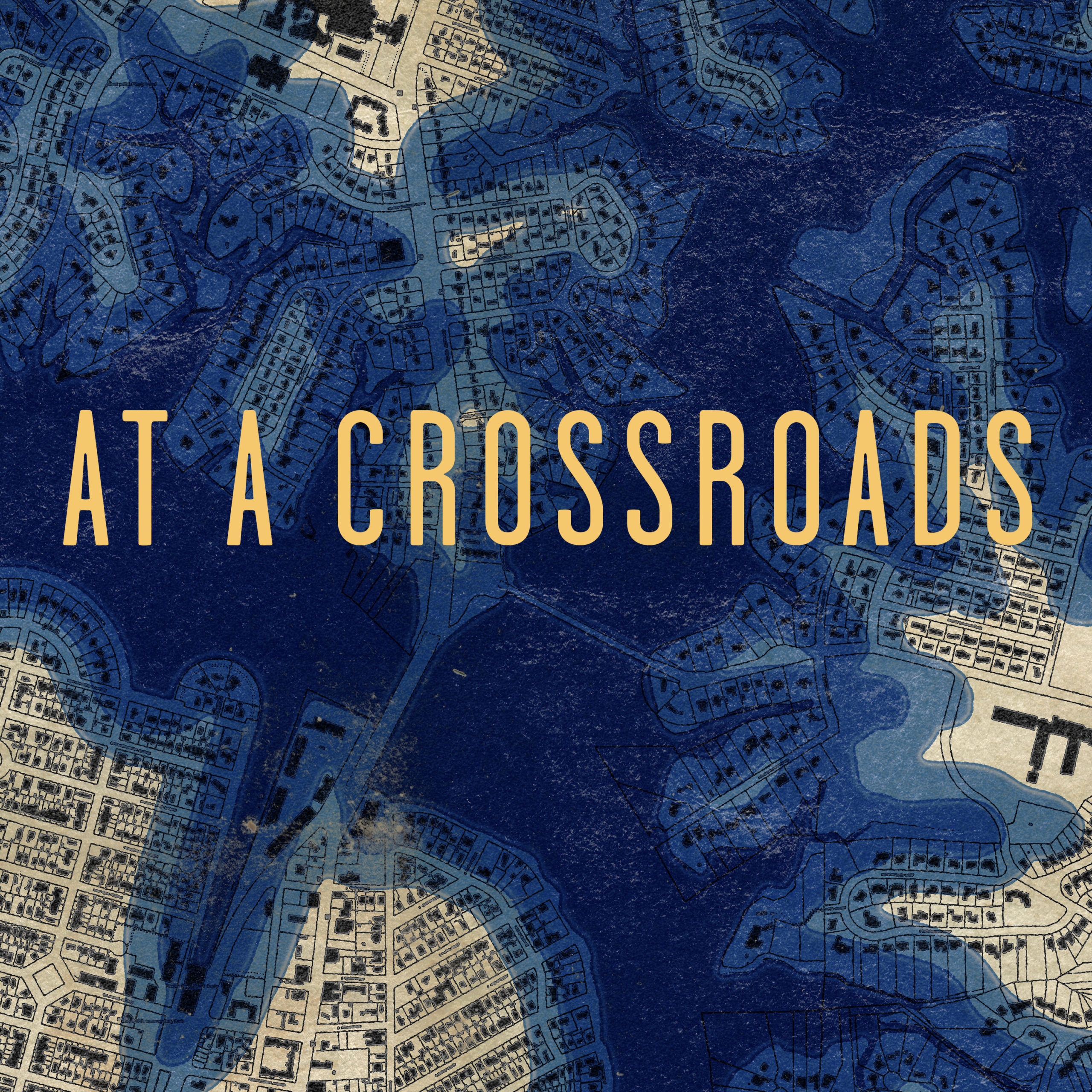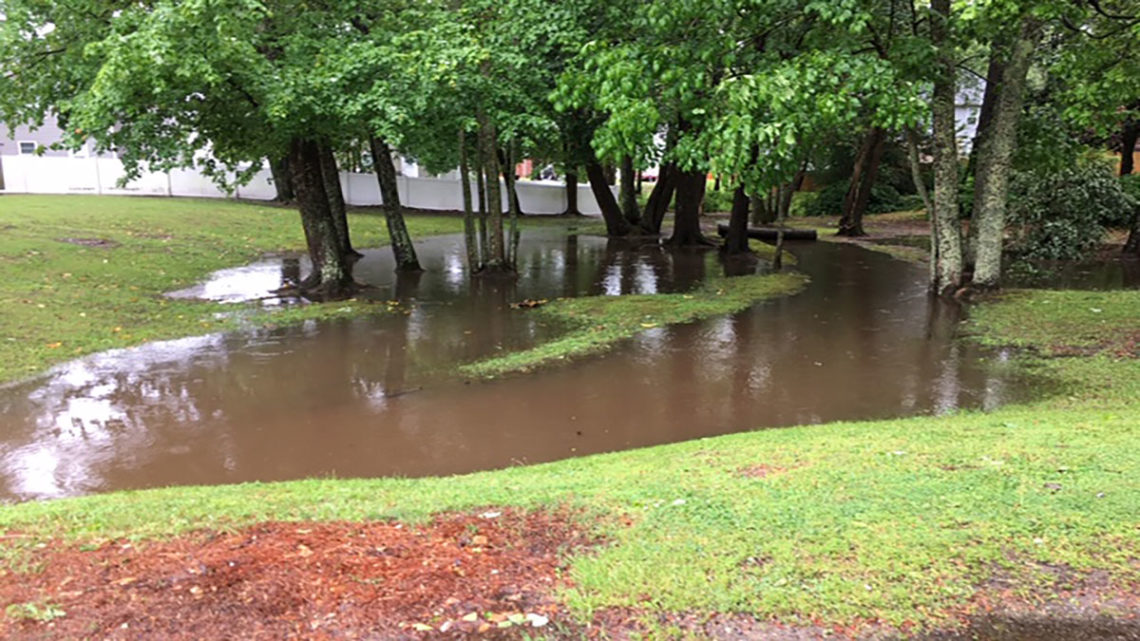Photo courtesy of Carolyn White. Pughsville residents blame a lack of infrastructure and maintenance for regular flooding that traps residents and inundates houses.
This story is part of “At A Crossroads,” a WHRO Public Media series exploring how coastal Virginia is dealing with higher waters due to climate change. The project is funded by the Pulitzer Center on Crisis Reporting as part of its nationwide Connected Coastlines reporting initiative.
By Ryan Murphy
One drizzly afternoon in early November, Carolyn White and Pamela Brandy cruise around in White’s SUV.
They can’t wait to start pointing out problem spots.
Overfilled ditches. Standing water. Inadequate pipes.
Welcome to Pughsville.
Generations ago, freed slaves set up a place to call their own in what was then Nansemond County. Their descendents still live there today, in the neighborhood that straddles the Suffolk/Chesapeake city line.
But they’re worried about how much longer they’ll be here.
As climate change makes rainstorms heavier and more frequent, Brandy and White and many of the other long-time Pughsville residents are afraid their neighborhood’s going to get washed away.
“That’s the Interstate up there (I-664) so water comes from up from the kind of take down owner because we in the valley, we get water coming from the interstate. We get water coming from Suffolk,” Brandy says, gesturing all around the car. “So we hold in all this water and water is not moving out because the drainage is up above us.”
Census figures show Suffolk’s population has grown eleven-and-a-half percent over the last decade, making it one of the fastest growing communities in Hampton Roads.
With that comes more building and as developments go up, residents of older neighborhoods feel like they’re being left behind.
Flooding is getting worse, and they say development is partly to blame.
Pughsville largely doesn’t have stormwater pipes, relying on ditches. All the water pools at the lowest point, where several streets dead-end at the foot of the interstate that looms over the neighborhood.
A pipe dug beneath the highway by the Virginia Department of Transportation is the only way for water to get out of this part of Pughsville. And it’s clogged.
Brandy says when a heavy rain happens, water creeps up those dead-end roads, flooding the homes on the low end of the street, blocking intersections further up and making it difficult for people to get in or out.
“But when we had that major flood that we had, water came up to this house here and all of this was flooding,” Brandy says, pointing to several homes at the end of the row. “This house here was underwater.”
But the topography and the worsening rains are only part of the problem.
What’s more pressing: development happening in and around Pughsville that existing residents say is making things worse for them.
White points out several newly-built homes scattered around the old neighborhood.
“I don’t think these two houses were supposed to be put here. But when developers come with money, the city says ‘OK,’” White says. Just behind a couple of new houses, she said “all of that is marsh land and water.”
When a new house goes in on a lot that was previously grass or woods, suddenly there’s a lot less soft soil and trees to absorb the rain. In its place is a lot more hard surface like roofs and driveways for water to run off of.
White and Brandy said that’s flooding out the immediate neighbors and compounding other problems. They also worry that larger developments around their community are channeling more water into their little valley.
They complain about a lack of maintenance – like that blocked up VDOT pipe – and the failure of the city to invest in stormwater management here in Pughsville.
But they said officials are shrugging off their flooding concerns, which is endangering their community and their heritage.
“The African-American legacy and our history, they’re building and removing by all this development that they are doing, and now we won’t have the history and legacy no more,” Brandy said.
In part, they feel like they’re ignored, or even targeted, because their community is historically Black.
“They building up all this new development over here and they got beautiful curbside drainage and everything, streets and stuff. OK, but you can’t do nothing in Pughsville?” Brandy said. “What’s the difference, huh? Oh, I forgot. We’re African-American. Oh, that’s the difference.”
“Black and white,” White echoed.
In 2019, they wrote to VDOT telling them their neighborhood was being discriminated against. They said someone from VDOT worked with them for a few months, but told them they didn’t have a claim after a meeting with the city.
They feel like the city isn’t listening to the existing residents, and instead the needs of new development take precedence over the old neighborhoods.
The city of Suffolk says they are working on Pughsville.
Suffolk’s public works director, Robert Lewis, said many of the concerns he’s heard about development are overblown.
He says the larger developments happening throughout the city, including those near Pughsville, are master planned with developer-constructed stormwater systems. He says that means the biggest swaths of development shouldn’t be major contributors to flooding for existing communities.
But he conceded that infill development – those scattered houses going up throughout Pughsville – can cause issues. He said the city’s ability to mitigate is limited.
“That infill property has just as much right to be there and develop a house as those neighbors that have been there for years,” Lewis said. “We’re trying to balance so that the property owner can use their rights of their property as they see fit without unduly impacting the folks adjacent to them and downstream.”
Lewis said VDOT is clearing that outfall pipe under the interstate so the water will drain.
The city’s rolled out plans for one new stormwater pipe to help get water to that outfall, and a detention pond should help slow the water flow down during heavy rains to limit peak flooding.
Lewis said once the planned projects are done, they would be a step in the right direction, but solving Pughsville’s flooding problems writ-large will take a lot more work.
And the city doesn’t currently have plans for any work beyond what’s on paper now, Lewis said. That could happen in the future, or maybe private developers who are putting up houses in the community will start putting some of that infrastructure in.
Community members have said what Suffolk proposed isn’t enough and doesn’t solve many of the problems they’ve communicated to city officials.
The pair from Pughsville say they can’t wait.
“All of this was flooded that these people back here in the new section couldn’t get out because there’s only one way out,” Brandy said. “We have asked them about getting a way out for people because these people are trapped and they haven’t came up with an answer on that. And they don’t care.”

